
2002 | OriginalPaper | Buchkapitel
What Does It Mean for a Computer to Do Diagrammatic Reasoning? A Functional Characterization of Diagrammatic Reasoning and Its Implications
verfasst von : B. Chandrasekaran
Erschienen in: Diagrammatic Representation and Inference
Verlag: Springer Berlin Heidelberg
Enthalten in: Professional Book Archive
Aktivieren Sie unsere intelligente Suche, um passende Fachinhalte oder Patente zu finden.
Wählen Sie Textabschnitte aus um mit Künstlicher Intelligenz passenden Patente zu finden. powered by
Markieren Sie Textabschnitte, um KI-gestützt weitere passende Inhalte zu finden. powered by
One might have thought that the issue of use of mental images in reasoning has been put to rest after years of debate, but one would be wrong. The journal Behavioral and Brain Sciences will soon publish a paper by Zenon Pylyshyn, which restates his earlier thesis - this time as a null hypothesis that cannot yet be rejected - that images do not play any role in reasoning, and that information which people often think they get from images when reasoning is really tacit knowledge that they already have. He does not compare the case of use of mental images with the case when the reasoner uses an external diagram for the same problem, so it is not clear if in those cases also he would claim that the diagram does not play a role. In any case, one might think that this is an issue for psychology, but not for artificial intelligence. However, conceptually, unless one has a robot with a vision system and the robot draws a diagram on a surface and uses its visual system to extract information as it reasons about a situation, any claim that a computer program performs diagrammatic reasoning in some situation has a status similar to that of the claims of human use of mental imagery during reasoning. In parallel with skeptics such as Pylyshyn of the role of images in reasoning, there are those in artificial intelligence who claim that the idea of diagrammatic reasoning by a computer is incoherent: what it means for the internal representation to be an image or a depiction is not clear, and the objections to “seeing” or perceiving information in such an image apply equally to the human and the computer cases. I do not think that the idea of computers performing diagrammatic reasoning is incoherent. I will argue my position on this by characterizing diagrammatic reasoning functionally. Then, I will argue that a computer program can be said to be performing this kind of reasoning if there exists a coherent and non-vacuous level of description of the operations of the program that satisfies the functional properties. Along the way, I will identify diagrammatic reasoning as an instance of a larger class of reasoning in which a model of some kind is used to get some information about a situation. Psychology has many more constraints about what sorts of models are available than artificial intelligence, which may be, at least in theory, freer in this regard.